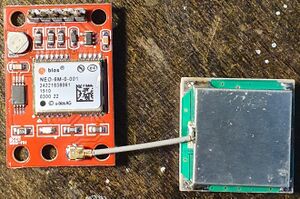GPS Module: Difference between revisions
NickPGSmith (talk | contribs) |
NickPGSmith (talk | contribs) |
||
| Line 73: | Line 73: | ||
** Falling Edge on TOS | ** Falling Edge on TOS | ||
** Cable Delay : 50 ns -> 20 ns (This compensates for cable delay between antenna and receiver) | ** Cable Delay : 50 ns -> 20 ns (This compensates for cable delay between antenna and receiver) | ||
*** At 0.7c, 1 m <=> 4.8 ns | |||
View -> Message View: | View -> Message View: | ||
Revision as of 20:05, 24 October 2024
HW-595 Board

- Based on uBlox NEO-6M-0-001
- Receiver Description
- 5V operation (3.3 V regulator onboard)
- UART: 4800 - 230400 bps (9600 bps 8N1 default), TTL levels buffered by 220R resistors
- U.FL connector supplies 3.3 V to active antenna
- Crystal Osc, not TCXO
- PPS LED: Invertion of PPS pin
- Battery-backed RAM contains config data and clock and speeds first-time-to-fix
- Data in NMEA 0183 format
- More background here
Board pinouts:
| Pin | Function | Description |
|---|---|---|
| 1 | PPS | 1 pulse/s, synchronised at rising edge, length 100 ms (by default) |
| 2 | RXD | UART input |
| 3 | TXD | UART output |
| 4 | GND | Ground |
| 5 | VCC | 3.3 - 5 V |
PPS:
- Send PPS to UART via CTS to allow GPSD to acurately sync
- Can be configured as a frequency reference: 0.25 Hz - 10 MHz
- Output has high frequency accuracy
- Suffers from jitter except at a few specific frequencies that divide into internal 48 MHz clock
- Configure in u-Center here
- Different frquencies/duty cycles can be configure for GPS synced/not synced
Software
U-Center
- U-Center
- Select COM port and Baud rate
- Communicates with uBlox with binary UBX Protocol
View -> Configuration View; to activate change: Send
- CFG (Configuration)
- Select: Save current configuration
- Select in Devices: 2-I2C-EEPROM
- PRT (Ports)
- Baud Rate : 9600 -> 115200
- TP5 (Timepulse 5)
- PPS Settings for no GPS lock (eg use as an "alert" signal):
- Frequency : 1 Hz
- Duty Cycle : 0% (for permanent low output)
- PPS Settings for GPS Locked:
- Frequency Locked : 1 Hz
- Duty Locked : 50%
- Falling Edge on TOS
- Cable Delay : 50 ns -> 20 ns (This compensates for cable delay between antenna and receiver)
- At 0.7c, 1 m <=> 4.8 ns
- PPS Settings for no GPS lock (eg use as an "alert" signal):
View -> Message View:
- Firmware version: UBX -> MON (Monitor) -> VER (Version)
- Currently: 7.03 (45969)
GPSD
- gpsd
- Packages: gpsd, gpsd-clients
Use of a serial device (eg ttyS0) is prefered over a USB/serial interface (eg ttyUSB0) due to lower latency and PPS availability.
Can be tested with something like (Debug level 4) :
gpsd -N -n -s 9600 -D 4 /dev/ttyS0 /dev/pps0
Lines showing visible/used satellites:
gpsd:PROG: SVINFO: visible=15 used=5 mask={SATELLITE|USED}
gpsd:INFO: CORE: PRN 6 az 47.0 el 20.0 ( 0.687248, 0.640869, 0.342020)
gpsd:INFO: CORE: PRN 11 az 93.0 el 22.0 ( 0.925913, -0.048525, 0.374607)
gpsd:INFO: CORE: PRN 12 az 70.0 el 58.0 ( 0.497961, 0.181243, 0.848048)
gpsd:INFO: CORE: PRN 28 az 301.0 el 35.0 (-0.702150, 0.421894, 0.573576)
gpsd:INFO: CORE: PRN 32 az 257.0 el 44.0 (-0.700903, -0.161816, 0.694658)
gpsd:INFO: CORE: Sats used (5):
Line showing time in UNIX Epoch: gpsd:PROG: TIMEGPS: time= 1728071281.000150311 mask={TIME}
Line showing PPS is asserted on control line. Here the control line is asserted with 0.5s delay:
gpsd:PROG: PPS:/dev/ttyUSB0 Assert accepted @ 1728071281.503229046 offset 0.496770954
Configuration in /etc/sysconfig/gpsd, which by default enables detection of USB devices via udev events including creation of a PPS device (/dev/pps0):
USBAUTO="true"
Options can be forced, eg:
OPTIONS="-n -s 9600" DEVICES="/dev/ttyS0 /dev/pps0"
Check data stream with gpsmon:
gpsmon /dev/ttyS0
when gpsd is not started, or connected to gpsd:
gpsmon
Show raw data:
gpscat -p -s 9600 /dev/ttyS0
Enable and start gpsd:
systemctl enable gpsd systemctl start gpsd
By default, gpsd listens on port 2947.
Monitor with:
cgps -s gpsmon gpscsv gpsplot --image gps.png xgps
Pulse Per Second (PPS)
With PPS output connected to a serial port pin, GPSD should detect it. If it is on GPIO or other serial port, this can be used to create a PPS device:
dnf install pps-tools modprobe pps_ldisc setserial -v /dev/ttyS0 low_latency ldattach PPS /dev/ttyS0
Check PPS signal:
ppstest /dev/pps0 ppscheck /dev/ttyS0
Can set at boot with udev rule (/etc/udev/rules.d/gps.rules):
KERNEL=="ttyS0", SYMLINK+="gps0" KERNEL=="ttyS0", RUN+="/usr/bin/setserial -v /dev/%k low_latency" KERNEL=="ttyS0", RUN+="/usr/sbin/ldattach PPS /dev/%k"
